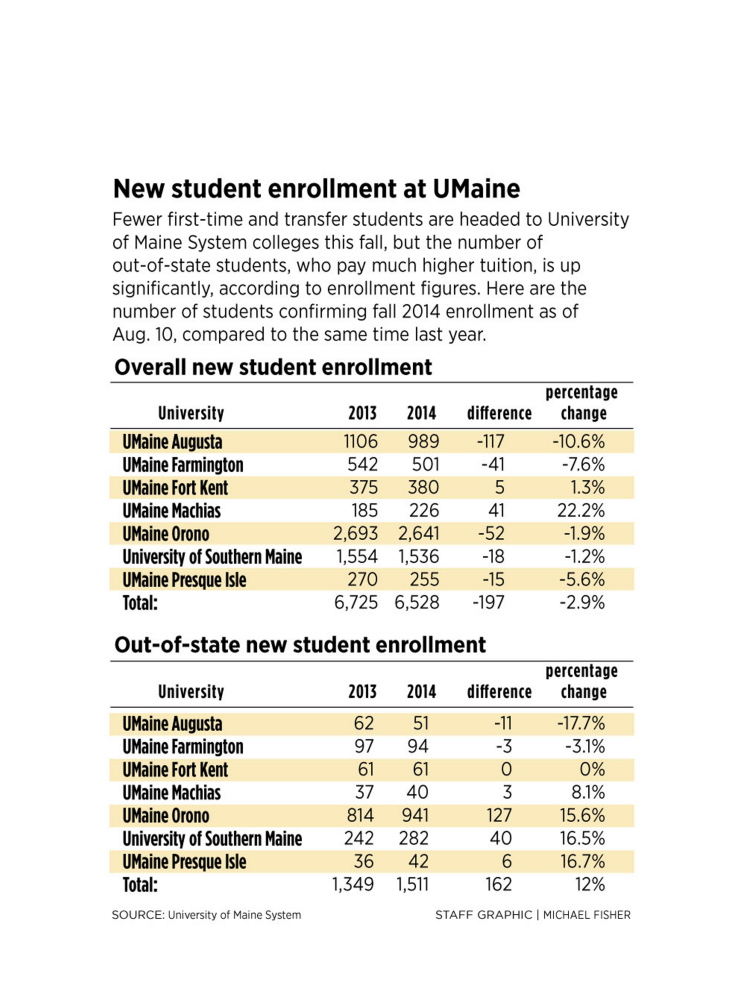There will be fewer first-time and transfer students in the University of Maine System this fall, but more of them are coming from outside the state and paying higher tuition – good news for the cash-strapped system.
Commitments from out-of-state students, who pay nearly three times the in-state tuition, are up 12 percent systemwide over the same period last year, according to the latest fall enrollment report issued Aug. 10. A total of 1,511 new out-of-state students will attend the system’s seven campuses, up 162 over last year.
“Maine is doing great on out-of-state numbers,” said Rosa Redonnett, chief student affairs officer for the system.
Its two biggest campuses, University of Maine in Orono and University of Southern Maine, have both attracted about 16 percent more out-of-state students, according to the report.
Orono has 941 new out-of-state students this fall who will pay $27,970 in tuition and fees, compared with $10,700 for in-state students. That means that group is bringing in about $26.3 million in tuition and fees, compared with $10 million if they paid in-state rates.
USM has 282 new out-of-state students paying $21,280, compared with $8,920 for in-state students. They’re bringing in $6 million, compared with $2.5 million if they paid in-state rates.
Targeting out-of-state students, from across the country and overseas, is a critical component of increasing revenue in Maine and other public universities, which faced deep cuts in state subsidies during the recession and are only now beginning to see increases in state allocations. But it’s getting tougher to recruit those students, since every state is essentially poaching one another’s high school graduates.
“There is not a campus that is not stepping this up nationwide. It’s intensely competitive,” Redonnett said.
University and state officials also are realizing they have to provide incentives to keep the in-state students they have, she said.
“More and more states are beefing up their in-state scholarships to keep their in-state students,” Redonnett said, noting that financial aid in Maine has been relatively unchanged for more than a decade.
Maine schools have had a recent advantage because tuition has been frozen since 2011, when state officials agreed not to cut higher education funding. That has been a powerful recruiting tool, officials say.
But more state funding is needed, and university system officials have said they will seek additional money in upcoming legislative sessions.
“States are being more strategic,” Redonnett said. “It can’t just rest on the back of the institution; there has to be state policy and an adequate investment in the institution.”
The UMaine System, which had 30,165 students overall in fall 2013, with 4,212 of those coming from out of state, has faced significant deficits for years, and each of the seven campuses already has made deep budget cuts. The latest system budget of $529 million, approved in May, cut 157 positions and required $11.4 million in emergency funds to close a $36 million deficit that officials said was caused by flat state funding, declining enrollment and tuition freezes.
Officials have said more cuts will be needed to head off future deficits. The system faces a projected deficit of $69 million in 2019.
While overall applications were up about 10 percent, from 22,811 to 25,050, enrollment commitments from new students are down 2.9 percent overall compared with the same time last year, dipping 1.2 percent at USM and 1.9 percent at Orono. The enrollment report is considered preliminary and final figures won’t be released until mid-October, but the numbers are considered solid estimates for campuses such as Orono and Farmington, which enroll more traditional students. Campuses such as USM and Augusta, with more non-traditional students, tend to see a late surge of students enrolling nearer to the first day of classes after Labor Day.
In-state enrollment systemwide is down about 6.7 percent, mirroring the state’s demographic trend of fewer high school graduates.
The enrollment data are being closely watched as system officials fight a string of budget deficits. The 2013-2014 budget closed a $42 million shortfall, and the year before, a gap of $43 million. Since 2007, the system has reduced its workforce by more than 650 full-time-equivalent employees.
Enrollments are down at five of the seven campuses, with the smallest campuses – Machias and Fort Kent – showing increases. Overall, UMaine-Machias, the smallest campus in the system, has seen a 22 percent increase in first-time and transfer students. That’s the result of intense recruitment under Melvin Adams, who was brought in a year ago to take over a combined position of dean of students and admissions.
Adams scoured federal data and used Facebook data to sell Machias’ marine biology program to students in coastal states and the Great Lakes area. He also launched “pie nights” at local high schools to help students with applications or financial aid forms for any college, sent out personalized acceptance letters and last spring attended high school graduation ceremonies to present the college’s incoming freshmen with scholarship certificates.
“They spent a lot of time honing their message, and working really aggressively with the sending schools in their area,” Redonnett said.
This fall, UMaine-Machias expects 226 first-time and transfer students, up from 185.
Officials at Fort Kent, up 1.3 percent, say they expanded their recruitment overseas to attract students to their nursing program.
An outside consultant contracted to recruit foreign students, specifically at Orono and USM, hasn’t met expectations. Study Group anticipated bringing in 400 students a year, but has enrolled only 40 students at Orono and one at USM this fall.
Send questions/comments to the editors.



